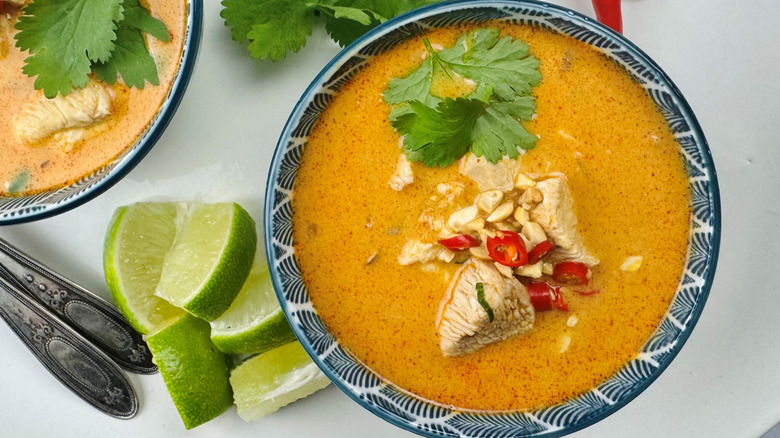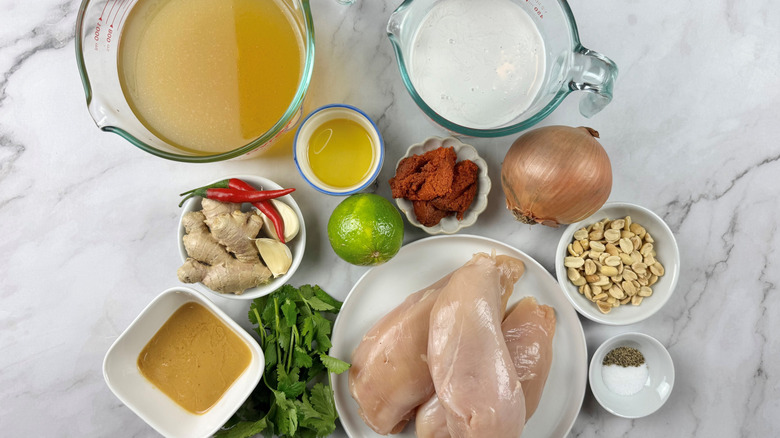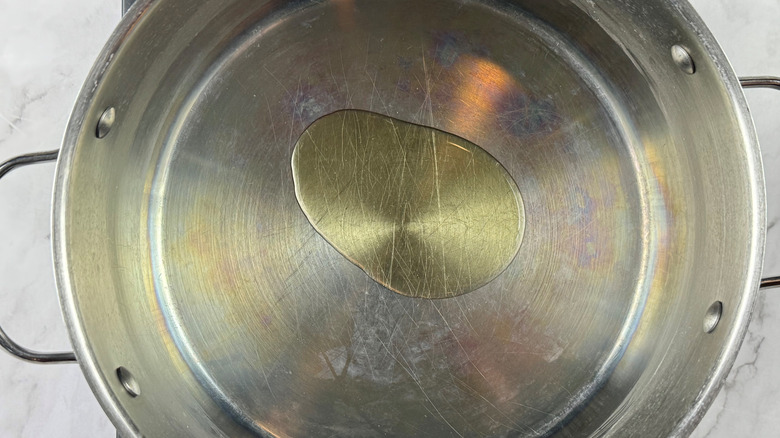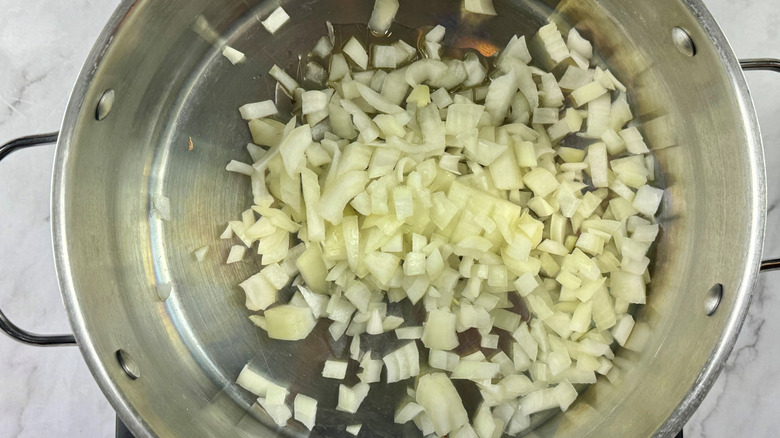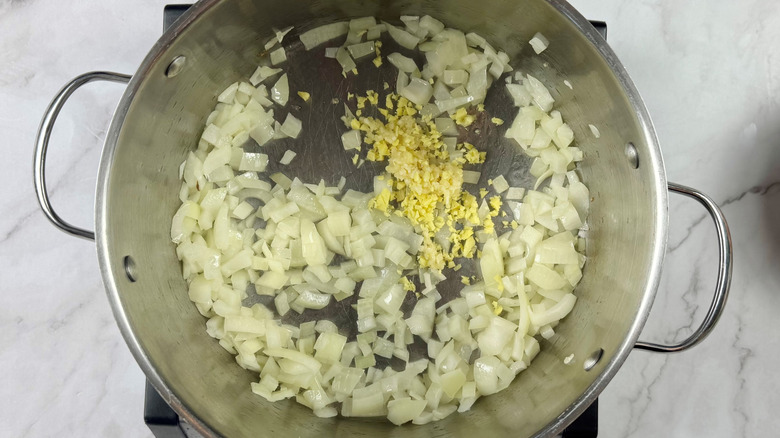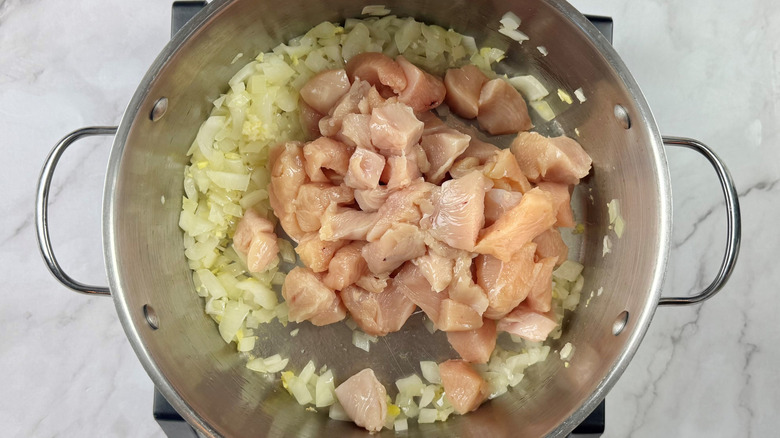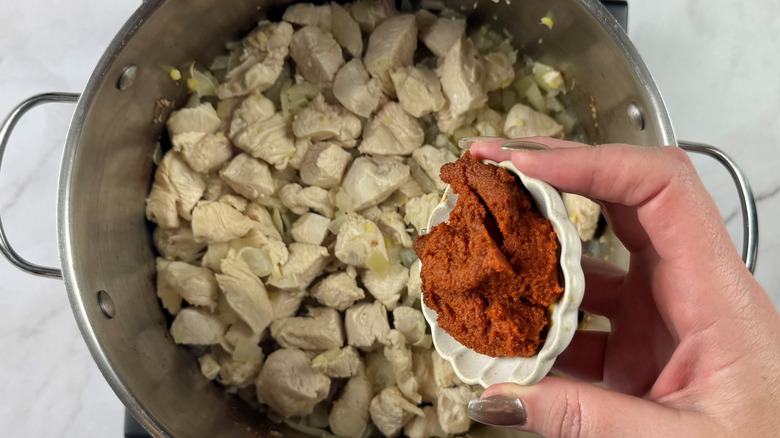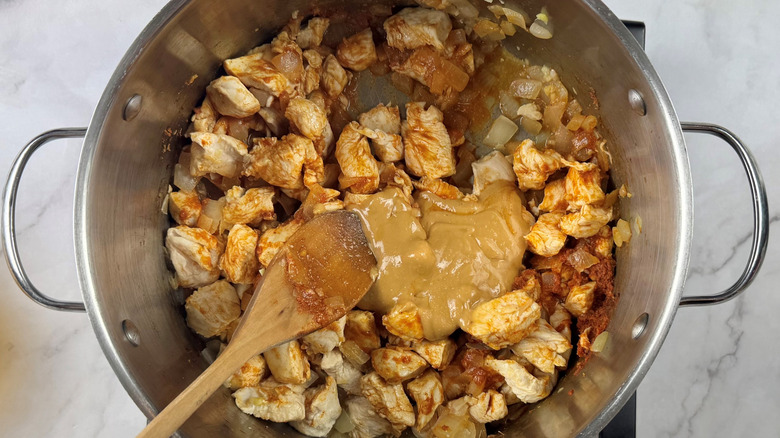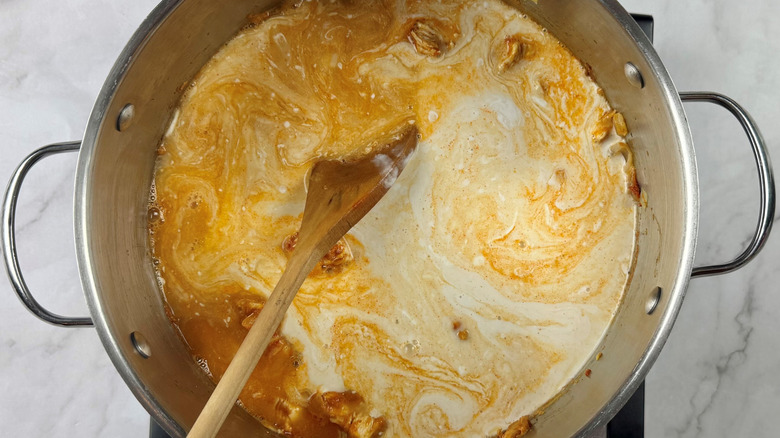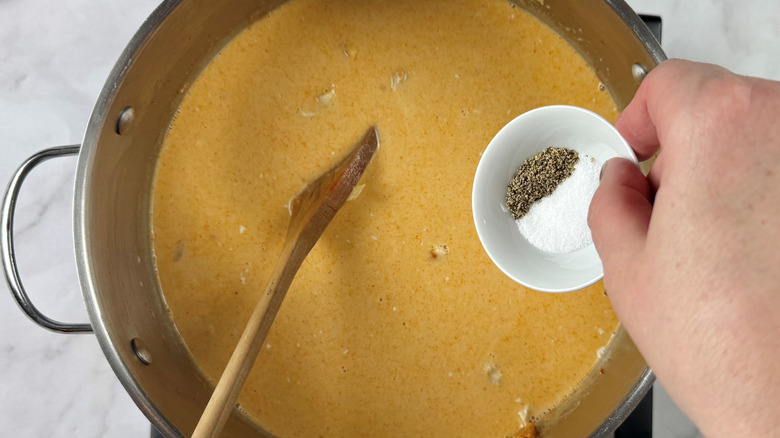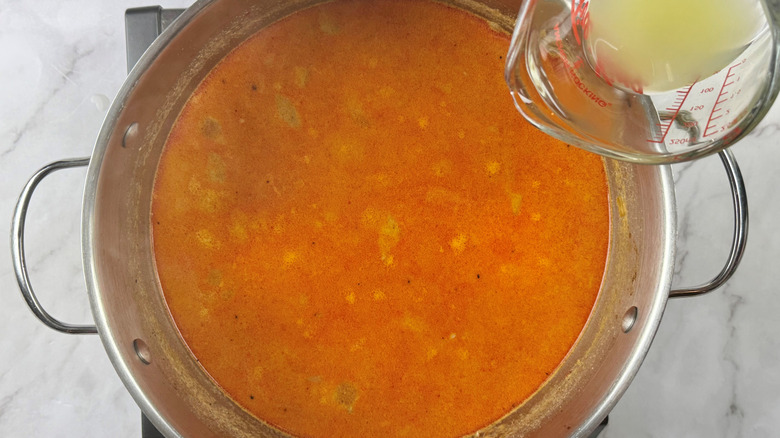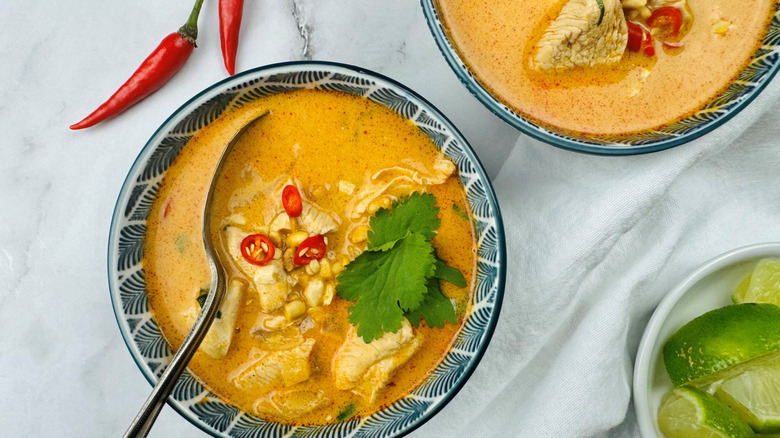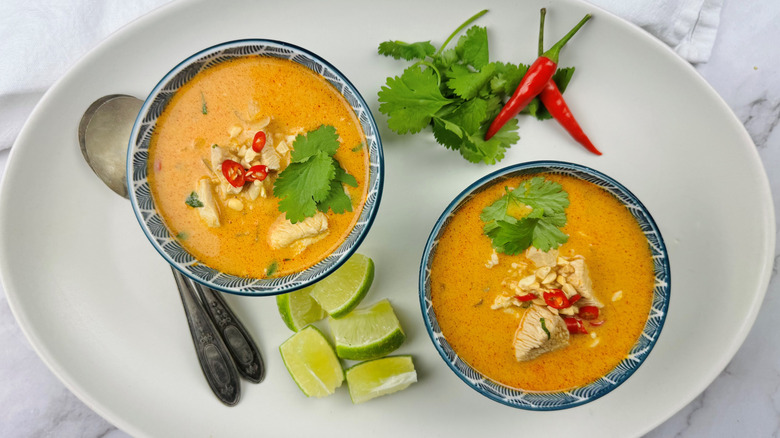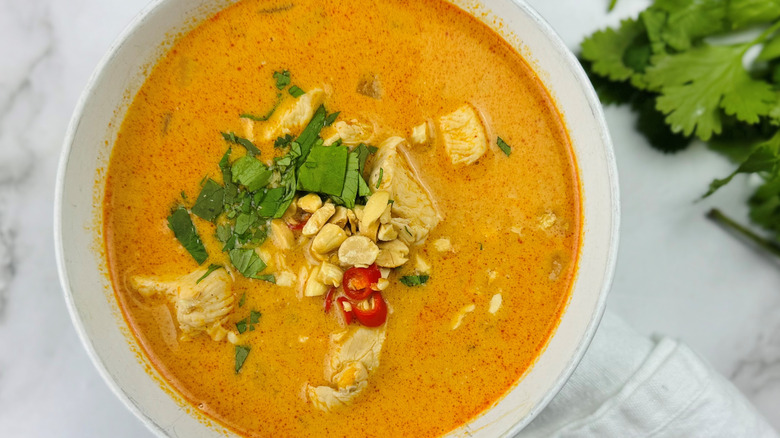Thai Curry Peanut Soup Recipe
As far as we're concerned, soup season is a year-round affair — and we're not just talking about gazpacho. Spicy soups are especially versatile, heating you up in the winter and making you sweat in the summer. No matter the time of year, you'll want to whip up this Thai curry peanut soup, courtesy of Food Republic recipe developer Julianne De Witt. "This comforting soup is hearty and satisfying and is so easy to make — it can be on your table in under 30 minutes," she comments.
The tantalizing taste is nothing to scoff at either. De Witt describes, "This soup has all the flavors that make Thai food so tasty — curry, lime, coconut milk, chiles." If you want to double down on the spice, it's easy to adapt this recipe by adding more Thai chili garnish. "I like to serve this soup with crusty bread and a zesty green mango salad on the side," De Witt says, though alternatively, she recommends pairing it with stir-fried noodles, like pad see ew. Be sure to make enough for leftovers, as De Witt notes, "This soup will taste even better the next day as the flavors have a chance to develop." Keep it in the fridge for up to three days or freeze it for a few months to savor whenever you fancy.
Gather the ingredients for Thai curry peanut soup
For this Thai curry peanut soup, you'll need olive oil, onion (diced), garlic cloves (minced), ginger (minced), and boneless skinless chicken breasts (diced). Then, get red curry paste, smooth peanut butter, chicken broth, canned coconut milk, sea salt, cracked black pepper, and lime juice.
Step 1: Heat oil
Add the oil to a large soup pot and place over medium heat.
Step 2: Cook onions
Add the onions and cook until soft.
Step 3: Add garlic and ginger
Stir in the garlic and ginger, cooking for 1 minute until garlic is fragrant.
Step 4: Brown the chicken
Add the chicken and cook until lightly browned, approximately 1 minute.
Step 5: Add curry paste
Stir in the curry paste, making sure to coat the chicken.
Step 6: Add peanut butter
Mix in the peanut butter.
Step 7: Pour in stock and coconut milk
Pour in the chicken stock and coconut milk and stir.
Step 8: Season, boil, and simmer
Season with the salt and pepper. Bring the soup to a boil, then simmer for 15 minutes.
Step 9: Add lime juice
Remove the soup from the heat and stir in the lime juice.
Step 10: Garnish and serve
Ladle the soup into bowls and garnish with crushed peanuts, diced chiles, and cilantro as desired.
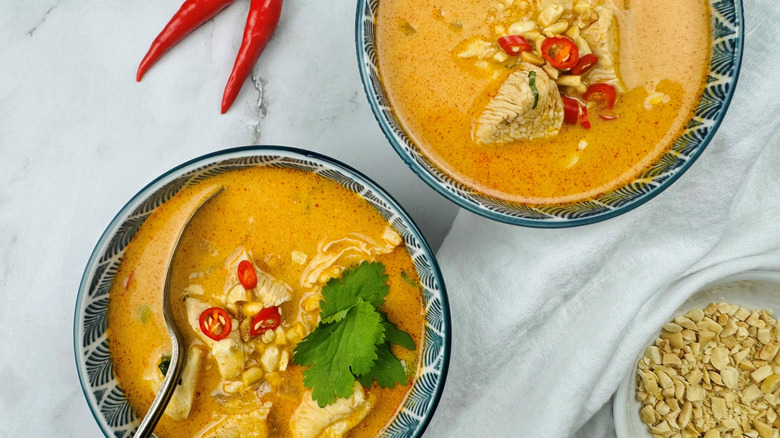
- 2 tablespoons olive oil
- 1 onion, diced
- 3 cloves minced garlic
- 1 tablespoon minced ginger
- 3 boneless skinless chicken breasts, diced
- ¼ cup red curry paste
- ¼ cup smooth peanut butter
- 3 cups chicken broth
- 1 (13.5-ounce) can coconut milk
- 1 teaspoon sea salt
- ½ teaspoon cracked black pepper
- Juice of 1 lime
- Cilantro, crushed peanuts, diced Thai chiles for garnish
- Add the oil to a large soup pot and place over medium heat.
- Add the onions and cook until soft.
- Stir in the garlic and ginger, cooking for 1 minute until garlic is fragrant.
- Add the chicken and cook until lightly browned, approximately 1 minute.
- Stir in the curry paste, making sure to coat the chicken.
- Mix in the peanut butter.
- Pour in the chicken stock and coconut milk and stir.
- Season with the salt and pepper. Bring the soup to a boil, then simmer for 15 minutes.
- Remove the soup from the heat and stir in the lime juice.
- Ladle the soup into bowls and garnish with crushed peanuts, diced chiles, and cilantro as desired.
Nutrition
| Calories per Serving | 696 |
| Total Fat | 43.9 g |
| Saturated Fat | 22.5 g |
| Trans Fat | 0.0 g |
| Cholesterol | 155.8 mg |
| Total Carbohydrates | 21.3 g |
| Dietary Fiber | 2.7 g |
| Total Sugars | 6.4 g |
| Sodium | 918.6 mg |
| Protein | 57.4 g |
Can I make this peanut soup vegetarian or vegan?
De Witt's Thai curry peanut soup incorporates chicken breast and chicken stock, but you can definitely keep this recipe vegan or vegetarian, per your desire. "Substitute vegetable broth for the chicken and add in extra vegetables — mushrooms, diced butternut squash, sweet potatoes, and bell peppers would work wonderfully," she suggests. As for the meat itself, De Witt recommends swapping in sauteed tofu or tempeh cubes, and even ramen noodles to add some bulk. Meanwhile, if you eat seafood, shrimp would make a great add-in too.
One thing to note, per De Witt: "Traditional red curry paste often has shrimp paste in it so use a plant-based version or make your own." It typically consists of flavor-packed ingredients like Thai chiles, ginger, garlic, onions, lemongrass, kaffir lime, and spices (for example, turmeric, coriander, cumin, and black pepper). Grind the components together for a rich seasoning for the soup and other curry recipes.
What is the difference between red, green, and yellow curry pastes?
If you're familiar with Thai food, you'll know that it includes several colorful curries, namely red, green, and yellow. De Witt gives us the rundown to clarify what distinguishes one from the other. As noted, red Thai curry paste features dry red chili peppers, lemongrass, garlic, ginger, spices, and traditionally, shrimp paste. "Red curry paste tends to be milder than green curry paste as the capsicum level tops out just as the color begins to turn from green to red," she explains. If you're purchasing red curry paste rather than making it yourself, she warns that "The spiciness can vary from brand to brand, so taste a little before using to gauge the heat."
Unlike red curry paste, green curry paste calls for fresh green chiles and lots of fresh coriander and Thai basil leaves. Yellow curry, on the other hand, heavily features turmeric, which gives it its golden hue. It's milder than red or green curry paste, so De Witt recommends it as "a great choice for children or those that don't like spicy foods."

